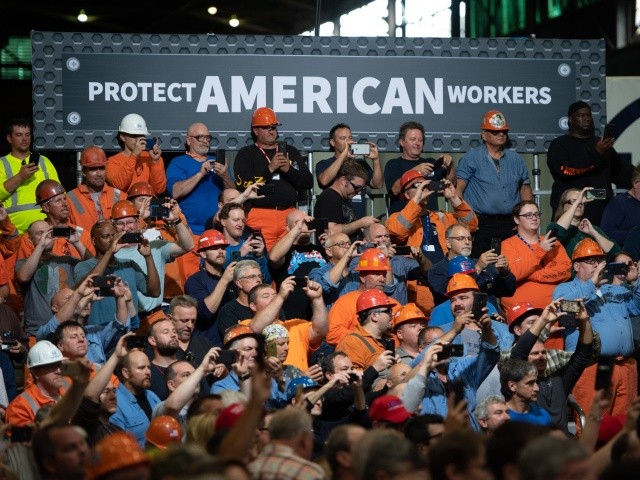President Donald Trump’s 2020 policies stopped the inflow of roughly 1.2 million foreign workers, according to a report by the business-funded Cato Institute.
“It’s a staggering cumulative reduction [since March 2020]… It’s undoubtedly contributing to America’s historic labor shortage,” tweeted Cato author David Bier.
However, the rollback of government interference in the nation’s labor market has been good for American employees. It has forced U.S. executives to raise employees’ wages, treat their employees with more respect, and also invest in workplace technology to help the employees to get more work done per shift.
But Cato represents the interests of the investors and CEOs who gain from the federal government’s deliberate, wage-cutting inflation of the labor supply. So the Cato report emphasizes the employers’ loss of labor and ignores the offsetting gains for employees and productivity.
“The Biden administration should open the borders now to allow more workers to fill open positions and increase economic growth,” concluded the report’s author, David Bier.
Trump slammed Joe Biden during the RNC for taking the donations of American workers while helping to offshore their jobs to China. https://t.co/fRNpC9fi46
— Breitbart News (@BreitbartNews) August 29, 2020
The Cato estimate of 1.2 million absent foreign workers is far higher than an October 4 report by Goldman Sachs:
We estimate that the drop in temporary worker visas since the start of the pandemic has reduced the size of the effective labor force by 400k workers, while the drop in immigration visas has reduced the labor force by 300k (Exhibit 3). Adding these together implies a 700k drag on labor supply.
The reductions “would imply a tighter labor market than it did last cycle,” said the Goldman report, which added. “As a result, we expect wage growth will remain at about 3¾% in 2022.”
The biggest drop in labor has been caused by many Americans’ short-term exit from jobs, not by migration reforms, the Wall Street Journal reported on October 14:
More than a year and a half into the pandemic, the U.S. is still missing around 4.3 million workers. That’s how much bigger the labor force would be if the participation rate—the share of the population 16 or older either working or looking for work—returned to its February 2020 level of 63.3%. In September, it stood at 61.6%.
Many observers say the economy can gain from the reduced workforce — and the reduced government inflation of the nation’s labor market with migrant labor.
“The labor scarcity we’re experiencing is real … [and] is an opportunity, not a crisis,” David Autor, a professor at the Massachusetts Institute of Technology, wrote in a September 4 article for the New York Times. “When employers pay more for human labor, they have an incentive to use it more productively … And one way to use people more productively is to train them.”
“Many businesses are responding to higher wage costs by boosting the output of the workers they have, with productivity up 5% from the first quarter of 2020,” the Wall Street Journal wrote.

Workers listen as U.S. President Donald Trump speaks about trade at U.S. Steel’s Granite City Works steel mill in Granite City, Illinois July 26, 2018. (SAUL LOEB/AFP via Getty Images)
Employers are also being forced to treat their employers better. “We don’t like to say this much, but it has long been the practice of many restaurants to hire staff as inexpensively as possible and provide them with the fewest benefits that they can,” said Bret Thorn, the senior food & beverage editor for Nation’s Restaurant News. “We all know this,” he added:
I guess that can be a good business plan when the labor pool is deep, which it’s not now and I doubt will be for the foreseeable future, but it’s also cruel.
Federal policy provides employers with roughly 1 million new workers, consumers, and renters each year via legal immigration. The government also keeps at least 1 million foreign temporary workers in professional jobs and provides the farm sector with roughly 250,000 temporary farm laborers.
The federal government also allows employers to hire a population of at least eight million illegal migrants, and also to import short-term workers who arrive with tourist visas.
The huge inflow of foreign workers damages Americans’ wages — and their ability to buy homes — especially among the roughly 4 million young Americans who enter the workforce each year.
Nationwide, the federal policy of extracting legal and illegal migrants from poor countries is deeply unpopular because of its economic impact on ordinary Americans.
A wide variety of pollsters have shown deep and broad opposition to labor migration and the inflow of temporary contract workers into jobs sought by young U.S. graduates. This pocketbook opposition is multiracial, cross-sex, non-racist, class-based, bipartisan, rational, persistent, and recognizes the solidarity that Americans owe to each other.
Immigration damages ordinary Americans’ career opportunities, cuts their wages, raises their rents, curbs their productivity, shrinks their political clout, widens regional wealth gaps, and wrecks their democratic, equality-promoting civic culture. It also pushes people towards drug addiction and minimizes the incentive for employers to help them escape.
In Maryland, deaths from synthetic opioids like fentanyl rose over 3,000% from 2013 to 2018.
More than a third of those deaths were in Baltimore. Now, a mobile treatment van helps those suffering for free: pic.twitter.com/zY4enXusyM
— AJ+ (@ajplus) October 21, 2019

COMMENTS
Please let us know if you're having issues with commenting.